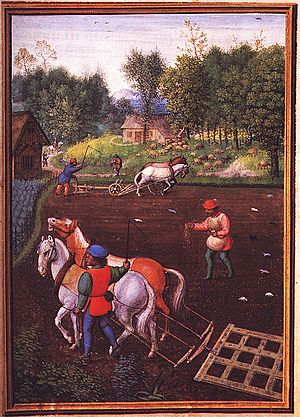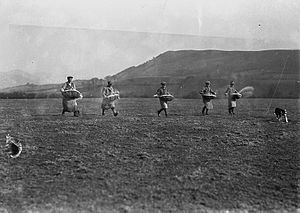Sowing facts for kids
Sowing is the process of putting seeds into the ground so they can grow into plants. When an area has had seeds placed in it, we say it has been sowed. It's a very old and important way to grow food and other plants!
Contents
What Plants Do We Sow?
Many important farm crops are sown. These include grains like oats, wheat, and rye. Grasses and plants like legumes (which include beans and peas) are also often sown. For bigger seeds like maize (corn) and soybeans, farmers usually "plant" them, which means putting them in wider rows with more exact spacing.
How Deep Should Seeds Go?
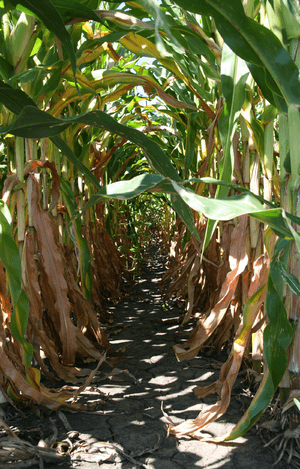
When you sow seeds, you usually don't put much soil over them. A good rule of thumb is to plant seeds about 2 to 3 times as deep as the seed's own size. This helps them get enough light and moisture to start growing.
Different Ways to Sow Seeds
When sowing seeds by hand, there are a few common methods:
- Flat sowing: Spreading seeds evenly over a flat area.
- Ridge sowing: Planting seeds along raised rows or ridges.
- Wide bed sowing: Sowing seeds in wide, flat areas that are prepared like garden beds.
You can also use different patterns when sowing:
- Regular rows: Seeds are planted in straight lines.
- Symmetrical grid pattern: Seeds are placed in a crisscross or diamond pattern. This can be helpful because it allows more sunlight to reach the young plants as they grow.
Types of Sowing Methods
Hand Sowing
Hand sowing is when you scatter handfuls of seeds over the ground. This is also called "broadcasting." After scattering, farmers often use a tool like a harrow to mix the seeds into the soil. Even though it takes a lot of effort for large areas, hand sowing is still used in some places. It takes practice to spread the seeds evenly! You can also use a hand seeder, which helps, especially with smaller seeds like those from grasses.
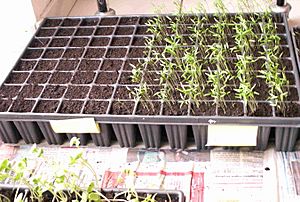
Sometimes, people start seeds indoors in seed trays. This is called "pre-sowing." It helps young plants grow strong in a warm place before they are moved outside, especially in colder weather like early spring.
Today, most seeds on farms are sown using a seed drill. This machine is much more precise. It places seeds evenly and at the right depth in the soil, which means less seed is wasted. Seed drills are usually pulled by tractors. The rows are typically about 10–30 centimeters (4–12 inches) apart, depending on the type of crop.
Farmers need to use the right amount of seed. If they sow too much, the plants might get too crowded. If they sow too little, there won't be enough plants, and weeds might take over, leading to a smaller harvest.
Open Field Sowing
Open-field planting is an older way of sowing where large fields are prepared and seeds are scattered directly onto the surface. In this method, the seeds are often left uncovered. This means they are exposed to the weather, like storms. This is different from modern gardening or farming, where seeds are usually placed under the soil and cared for more closely to help them grow better.
Preparing Seeds and Soil Before Sowing
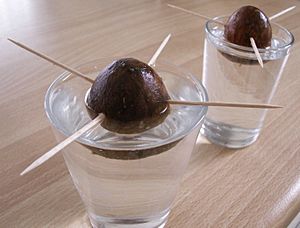
Before you sow certain seeds, they might need special treatment. This can help them sprout more easily. Some common treatments include:
- Seed scarification: Making small nicks or scratches on the seed coat to help water get in.
- Stratification: Giving seeds a cold, moist period, like winter, to help them sprout.
- Seed soaking: Placing seeds in water for a day or two.
- Seed cleaning: Washing seeds, especially from fruits, to remove any fruit flesh. This helps prevent insects or diseases from attacking the seeds. For example, washing tropical fruit seeds like lychees in warm water helps kill any tiny organisms on their skin.
It's also important to use healthy soil. For some seeds, especially tricky ones like certain tropical fruits, treating the soil can make a big difference. Two ways to treat soil are:
- Pasteurization: Heating the soil to a certain temperature (like 120 °C or 250 °F for 15 minutes) to kill most harmful germs without killing all helpful organisms.
- Sterilization: Heating the soil to a higher temperature to kill almost all organisms. This is used for very difficult plants.
Images for kids
-
A tray used in horticulture (for sowing and taking plant cuttings)
See also
 In Spanish: Siembra para niños
In Spanish: Siembra para niños


